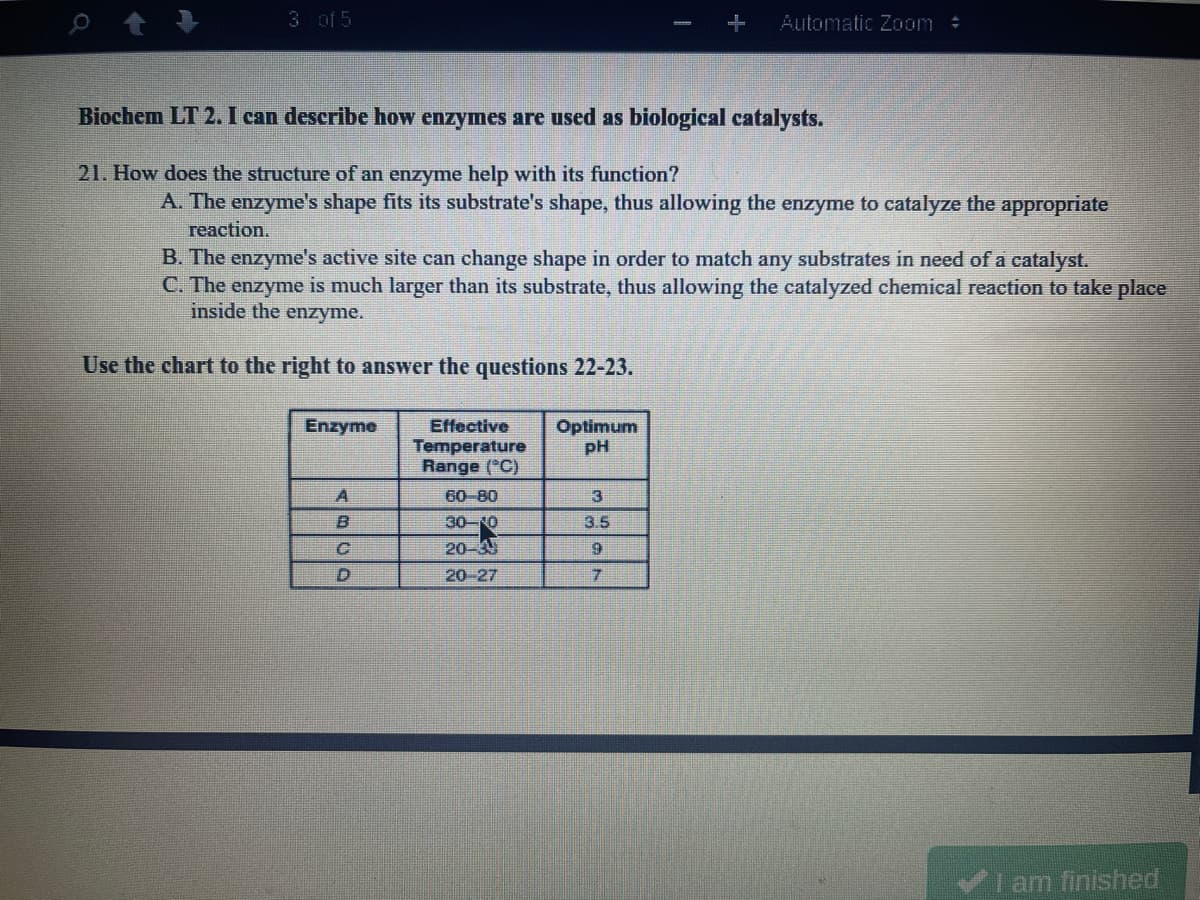Biochem LT 2. I can describe how enzymes are used as biological catalysts. 21. How does the structure of an enzyme help with its function? A. The enzyme's shape fits its substrate's shape, thus allowing the enzyme to catalyze the appropriate reaction. B. The enzyme's active site can change shape in order to match any substrates in need of a catalyst. C. The enzyme is much larger than its substrate, thus allowing the catalyzed chemical reaction to take plac inside the enzyme. Use the chart to the right to answer the questions 22-23. Optimum pH Enzyme Effective Temperature Range (C)
Biochem LT 2. I can describe how enzymes are used as biological catalysts. 21. How does the structure of an enzyme help with its function? A. The enzyme's shape fits its substrate's shape, thus allowing the enzyme to catalyze the appropriate reaction. B. The enzyme's active site can change shape in order to match any substrates in need of a catalyst. C. The enzyme is much larger than its substrate, thus allowing the catalyzed chemical reaction to take plac inside the enzyme. Use the chart to the right to answer the questions 22-23. Optimum pH Enzyme Effective Temperature Range (C)
Biology: The Dynamic Science (MindTap Course List)
4th Edition
ISBN:9781305389892
Author:Peter J. Russell, Paul E. Hertz, Beverly McMillan
Publisher:Peter J. Russell, Paul E. Hertz, Beverly McMillan
Chapter6: Energy, Enzymes, And Biological Reactions
Section: Chapter Questions
Problem 6TYK: Which of the following methods is not used by enzymes to increase the rate of reactions? a. covalent...
Related questions
Question

Transcribed Image Text:3 of 5
Automatic Zom
Biochem LT 2. I can describe how enzymes are used as biological catalysts.
21. How does the structure of an enzyme help with its function?
A. The enzyme's shape fits its substrate's shape, thus allowing the enzyme to catalyze the appropriate
reaction.
B. The enzyme's active site can change shape in order to match any substrates in need of a catalyst.
C. The enzyme is much larger than its substrate, thus allowing the catalyzed chemical reaction to take place
inside the enzyme.
Use the chart to the right to answer the questions 22-23.
Enzyme
Effective
Temperature
Range ("C)
Optimum
pH
60 80
B.
30-NO
3.5
20-3
20-27
7.
VI am finished
Expert Solution
This question has been solved!
Explore an expertly crafted, step-by-step solution for a thorough understanding of key concepts.
Step by step
Solved in 5 steps

Recommended textbooks for you

Biology: The Dynamic Science (MindTap Course List)
Biology
ISBN:
9781305389892
Author:
Peter J. Russell, Paul E. Hertz, Beverly McMillan
Publisher:
Cengage Learning

Biology 2e
Biology
ISBN:
9781947172517
Author:
Matthew Douglas, Jung Choi, Mary Ann Clark
Publisher:
OpenStax

Biology: The Unity and Diversity of Life (MindTap…
Biology
ISBN:
9781305073951
Author:
Cecie Starr, Ralph Taggart, Christine Evers, Lisa Starr
Publisher:
Cengage Learning

Biology: The Dynamic Science (MindTap Course List)
Biology
ISBN:
9781305389892
Author:
Peter J. Russell, Paul E. Hertz, Beverly McMillan
Publisher:
Cengage Learning

Biology 2e
Biology
ISBN:
9781947172517
Author:
Matthew Douglas, Jung Choi, Mary Ann Clark
Publisher:
OpenStax

Biology: The Unity and Diversity of Life (MindTap…
Biology
ISBN:
9781305073951
Author:
Cecie Starr, Ralph Taggart, Christine Evers, Lisa Starr
Publisher:
Cengage Learning

Anatomy & Physiology
Biology
ISBN:
9781938168130
Author:
Kelly A. Young, James A. Wise, Peter DeSaix, Dean H. Kruse, Brandon Poe, Eddie Johnson, Jody E. Johnson, Oksana Korol, J. Gordon Betts, Mark Womble
Publisher:
OpenStax College

Biology: The Unity and Diversity of Life (MindTap…
Biology
ISBN:
9781337408332
Author:
Cecie Starr, Ralph Taggart, Christine Evers, Lisa Starr
Publisher:
Cengage Learning